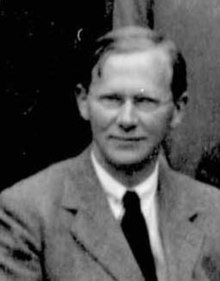Herbert Turnbull
Prof Herbert Westren Turnbull FRS FRSE LLD (31 August 1885 – 4 May 1961) was an English mathematician.[2][1][3] From 1921 to 1950 he was Regius Professor of Mathematics at the University of St Andrews.[4]
Herbert Turnbull | |
|---|---|
 from 1926 | |
| Born | Herbert Westren Turnbull 31 August 1885 Tettenhall, Wolverhampton, Staffordshire, England |
| Died | 4 May 1961 (aged 75) |
| Nationality | British |
| Awards | Smith's Prize (1909) Fellow of the Royal Society[1] |
| Scientific career | |
| Institutions | University of St Andrews |
| Doctoral students | Walter Ledermann[2] |
Life
He was born in the Tettenhall district, on the outskirts of Wolverhampton on 31 August 1885, the eldest of five sons of William Peveril Turnbull, HM Inspector of Schools. He was educated at Sheffield Grammar School then studied Mathematics at Cambridge University graduating MA..[5]
After serving as lecturer at St. Catharine’s College, Cambridge (1909), the University of Liverpool (1910), and the University of Hong Kong (1912), Turnbull became master at St. Stephen’s College in Hong Kong (1911–15), and warden of the University Hostel (1913–15). He was a Fellow at St John’s College, Oxford (1919–26), and from 1921 held a chair of mathematics at the University of St Andrews.
In 1922 he was elected a Fellow of the Royal Society of Edinburgh. His proposers were Arthur Crichton Mitchell, Sir Edmund Taylor Whittaker, Cargill Gilston Knott, and Herbert Stanley Allen. He won the Society's Keith Prize for 1923-25 and the Gunning Victoria Jubilee Prize for 1940-1944. In 1932 he was elected a Fellow of the Royal Society.[6]
He was a keen mountain climber and served as President of the Scottish Mountaineering Club from 1948 to 1950.
He retired in 1950 and died at Grasmere in the Lake District on 4 May 1951.
Family
In 1911 he married Ella Drummond Williamson, daughter of Canon H. D. Williamson. They had one daughter.[7]
Selected publications
- The Theory of Determinants, Matrices, and Invariants. 1928.
- The Great Mathematicians. 1929.
- Theory of Equations. 1939.
- The Mathematical Discoveries of Newton. 1945.
- with A. C. Aitken: An Introduction to the Theory of Canonical Matrices. 1945.
- as editor: The correspondence of Isaac Newton, first 3 vols (1959–1961) out of a total of 7 vols (1959–77).
References
- Aitken, A. C. (1962). "Herbert Westren Turnbull 1885-1961". Biographical Memoirs of Fellows of the Royal Society. 8: 149. doi:10.1098/rsbm.1962.0011. JSTOR 769468.
- Herbert Turnbull at the Mathematics Genealogy Project
- "Herbert Westren Turnbull". Britannica.com. Retrieved 14 January 2013.
- O'Connor, John J.; Robertson, Edmund F., "Herbert Westren Turnbull", MacTutor History of Mathematics archive, University of St Andrews.
- Biographical Index of Former Fellows of the Royal Society of Edinburgh 1783–2002 (PDF). The Royal Society of Edinburgh. July 2006. ISBN 0 902 198 84 X.
- "Fellow details". Royal Society. Retrieved 20 November 2017.
- http://www-history.mcs.st-and.ac.uk/Biographies/Turnbull.html